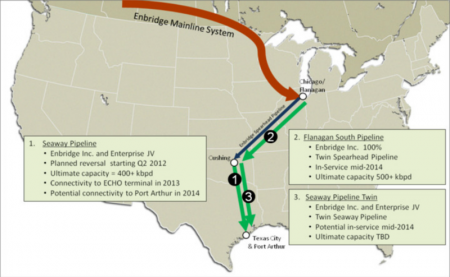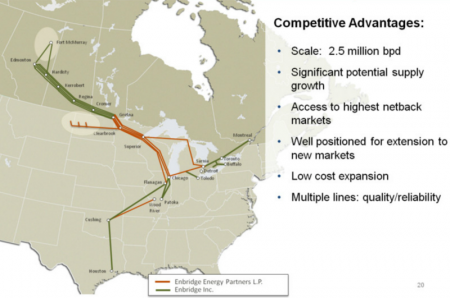Mar
28
US Consumers and Environmentalists Win One on Oil Shipping
March 28, 2012 | 6 Comments
It didn’t take long for the oil industry to go to Plan B to get the massive new supplies of Bakken Formation oil in North Dakota and the Canadian Oil Sands to the remaining refineries at the Gulf Coast. It may not overcome the closing of refineries on the US east and west coasts, but the nation will get it own oil and its good neighbor’s supplies refined and off to market. It’s likely a more expensive alternative, but the current administration has made it clear the citizens, the neighbors and the economy are not important in the political calculation.
It’s also a boon to environmentalists. For the ones still thinking about the world we live in and means to a better future keeping the crude oil off the roads and rails is a great relief. While some extremists avidly look for a future freed of carbon based energy stores, the Plan B might come as a shock, but banking one’s dreams on the CO2 idea has always been doomed.
The trigger for the announcement yesterday was Enbridge Inc. and Enterprise Products Partners L.P. have secured pipeline capacity commitments from oil shippers. There hasn’t been any doubt the oil could flow, the documents needed signed and on file to secure the financing and get underway with construction.
The various phases are going to go around both the political barrier of the President and the contentious Nebraska territory over the massive Ogallala Aquifer. Nebraska had its arrangement over the aquifer for the Keystone worked out long ago, a fact the administration and major media simply didn’t care to see. The bad news is the jobs, construction and investment is getting moved 4 –500 miles away. South Dakota, Nebraska and Kansas folks might see this as a betrayal, but the oil needs moved and no one needs crude oil in trucks and rail cars going hundreds of miles.
What is planned is a 512-mile, 30-inch diameter twin (a parallel line) along the route of the Seaway Pipeline from the big hub at Cushing Oklahoma to the Gulf Coast refining center, adding 450,000 bpd of capacity to the existing system (for a total 850,000 bpd).
Heading to the north via the northeast, Enbridge announced plans to proceed with an expansion of its Flanagan South Project. This pipeline is named as it starts from Flanagan, Illinois and goes to Cushing, Oklahoma. The line will be upsized to a 36-inch diameter line with an initial capacity of 585,000 barrels per day (bpd). The Flanagan South Pipeline project will be constructed along the route of Enbridge’s existing Spearhead Pipeline connecting the Flanagan Terminal, southwest of Chicago, to Enbridge’s Cushing Terminal in Oklahoma.
On to the north the Flanagan Terminal connects to the Enbridge pipeline system reaching up to the Bakken Oil formation field of North Dakota and Canada, on to Edmonton and finally up to Fort McMurray in the center of the oil sands field.
This means a lot more oil can get to the US refineries at the Gulf Coast by pipeline. The refineries have been getting oil from pipelines to be sure, but the new pipeline capacities can displace some ocean going tanker traffic.
The new oil supplies are going to saturate the Gulf Coast refinery complex. The pipeline firms announced construction of a new 85-mile 30-inch diameter pipeline that will be built from Enterprise’s ECHO crude oil terminal southeast of Houston to the Port Arthur/Beaumont, Texas refining center, which will give shippers access to heavy oil refineries on the Gulf Coast, too.
On the money angle the total estimated cost of the Flanagan South Pipeline project has increased from the original $1.9 billion to $2.8 billion. In addition, Enbridge’s share of the cost of the Seaway Pipeline twin line and extension with TransCanada is expected to be approximately $1.0 billion.
Most of the major work is due to complete before mid 2014. Its reasonable to expect interference from those special interests so entrancing the administration and stimulus for legal and bureaucratic activists. But the barriers are not at the top of the political power structure. The projects will very likely get done.
The consumer benefit will not be so good as the Keystone XL project could have been, but its still a badly needed win. There will not be much reduction in eat and west coast gasoline prices, but there will be crude oil to supply the gasoline. The North American Oil Industry will get to make some money in the world oil market as exporters of finished products.
This is good and very welcome news.
Comments
6 Comments so far




In his second term – President Obama will have more ‘flexibility’ in shutting down this project as well.
Green politicians and activists are living on borrowed time. If they can’t shut down big energy projects (hydrocarbons and nuclear) relatively quickly and make everyone dependent on unreliable big wind and big solar, they are in danger of becoming obsolete.
[…] Source: US Consumers and Environmentalists Win One on Oil Shipping […]
Last I checked about $4 trillion of our ~$15 trillion national debt was due to trade deficits buying foreign oil. This author seems to not get this point, and would have us continue on this destructive path (yes, Canada is a foreign country).
Meanwhile, the rest of the world is developing alternative energy plans. Germany will use its excess wind energy to produce hydrogen, and is inverting in a hydrogen infrastructure. Toyota has invested heavily in fuel cell technology for all sized vehicles.
I remember when America used to lead. Now we are stuck in a quagmire of ancient technologies serving the interests of the fossil-fuel industry.
We don’t need your help; get out of the way of pregress.
Sorry for the typos; need to get my glasses adjusted.
Transportation of oil by tankers and supertankers is a key method of transportation. Today it occupies the lion’s share in all the movements of “black gold”, significantly ahead of the pipeline method (widespread in Russia).
The first, in a relatively modern engineering embodiment, had a capacity of up to 250 tons and was involved in the transportation of oil products (in particular, kerosene) from Baku to Volgograd.
Oil transportation by sea
The carrying capacity of most large modern tankers is measured in tens of thousands of tons. Significant displacement and stunning dimensions of these transport vessels do not allow them to berth at every port. Only a limited number of maritime cities have appropriately equipped berths. There are frequent cases when the delivery of oil to the destination – the oil terminal – is carried out by smaller vessels moving between the supertanker and the port of destination.
In other cases, loading of raw materials is carried out from onshore terminals, and unloading – by pumping out by pumps and local pipelines located on the ship. In the modern world, according to various sources, oil and its products are transported by at least 4 thousand tankers, most often in continuous movement. To avoid leaks, at the initiative of a special European Commission, single-hull vessels were dismantled and / or converted into floating oil storage facilities, and replaced by double-hull tankers.
Tankers are loaded with raw materials in regions of key strategic purpose. That is why any geopolitical upheavals that take place in these geographic zones can significantly destabilize the international oil market and the state of the international economy as a whole.